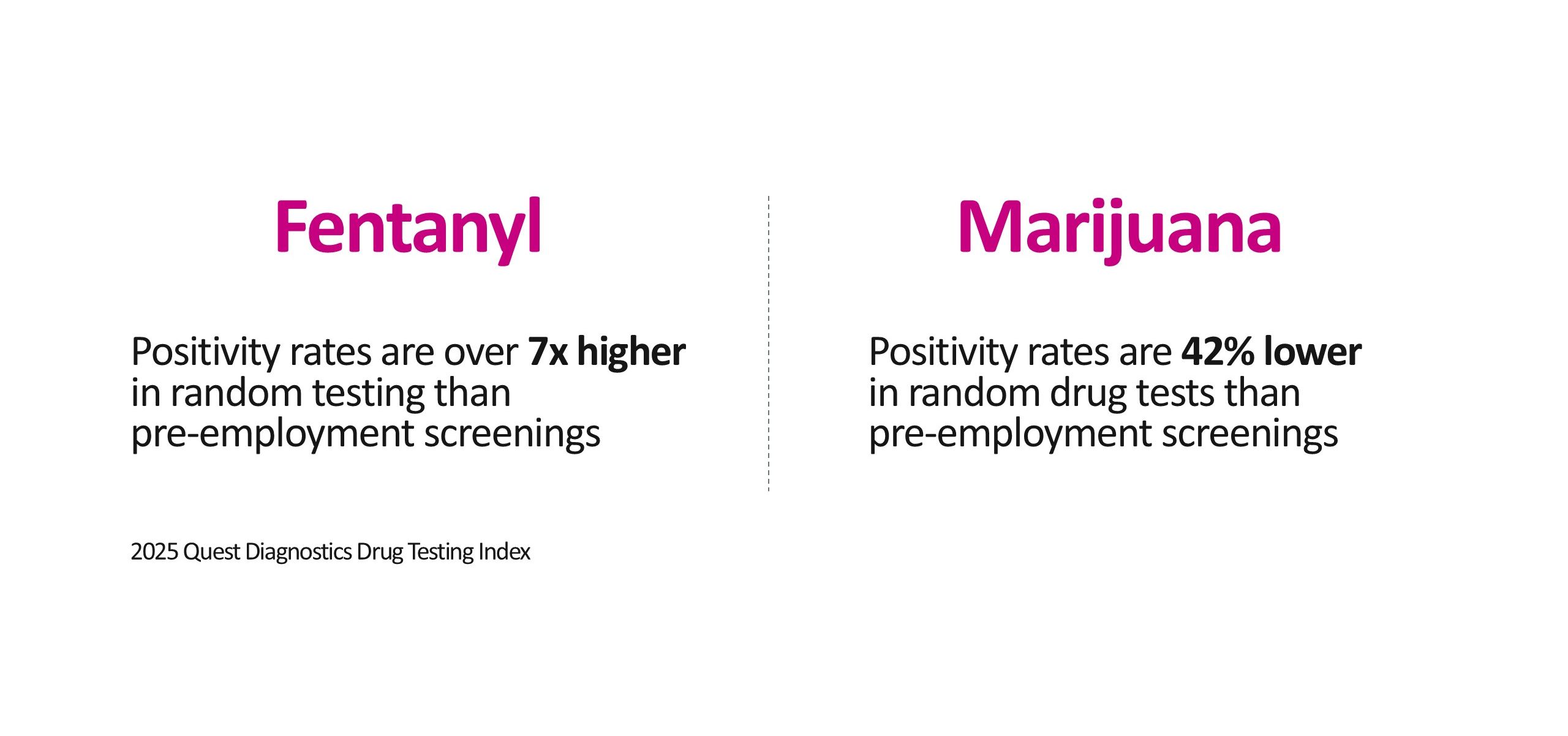3 Drug Testing Trends Transportation Fleets Can’t Ignore
4 min read
Published
Oct 24, 2025

As the U.S. Department of Transportation (DOT) looks to include fentanyl in its drug testing panel for safety-sensitive roles, transportation employers face a critical moment to reassess their drug testing strategies, specifically their random drug testing program.
The latest data from the 2025 Quest Diagnostics Drug Testing Index™ reveals a surge in fentanyl positivity rates, a shift in substance use patterns that could have serious implications for workplace safety and compliance.
Here are three key trends every transportation company should be aware of when it comes to random drug testing:
1. Fentanyl Positivity Rates Are Skyrocketing in Random Drug Tests
According to Quest Diagnostics, fentanyl positivity in the general U.S. workforce was 707% higher in random drug tests (1.13%) compared to pre-employment tests (0.14%) in 2024. This dramatic increase suggests that while candidates may abstain from drug use during the hiring process, ongoing use, particularly of fentanyl, is far more prevalent among current employees.

This trend is especially concerning for transportation employers, where safety-sensitive roles require strict adherence to drug-free policies. Fentanyl, which is 50 times stronger than heroin, poses a large risk not only to the user but to coworkers and the public. Its potential inclusion in the DOT drug testing panel is a direct response to this growing threat.
Action Step: Employers should ensure their random drug testing program are robust and frequent. Also be prepared for the potential of fentanyl being added to drug testing panels if the DOT’s proposed rule passes. Consider reviewing your drug testing policies and communicating clearly with employees about the risks and consequences of fentanyl use.
2. Multiple Substance Use Is Becoming More Common
The Quest report also found that 60% of specimens that tested positive for fentanyl were also positive for other drugs, with 22% also testing positive for marijuana. This indicates a rise in individuals consuming multiple substances simultaneously, which can amplify impairment and increase the likelihood of accidents or errors on the job.
For transportation companies, this is a red flag. Drivers, operators, and other safety-sensitive personnel under the influence of multiple substances pose a compounded risk. Multiple drug use can also complicate treatment and recovery efforts, making it harder for employers to support affected workers.
Action Step: Employers should work with their drug testing providers to make sure their panels can detect multiple substances. Also, consider implementing educational programs that address the dangers of various drug use. Partnering with Employee Assistance Programs (EAPs) can help provide support for those struggling with substance use.
3. Fentanyl Use Surges Post-Hire, Unlike Marijuana
While fentanyl is grabbing headlines, marijuana continues to be the most detected substance in drug tests. And recent data from the 2025 Quest Diagnostics Drug Testing Index reveals a surprising contrast in usage patterns:
- Marijuana positivity rates are actually 42% lower in random drug tests than in pre-employment screenings, suggesting many individuals abstain once hired.
- Fentanyl tells a different story: its positivity rate is over seven times higher in random testing, indicating that use often begins or escalates after employment.

As more states legalize marijuana for recreational and medicinal use, employers face increasing challenges in balancing compliance with evolving social norms. For DOT-covered roles, marijuana remains prohibited, regardless of state law. But for non-DOT roles, employers must navigate a complex landscape of legal and operational considerations.
Action Step: Transportation employers should maintain clear, role-specific drug policies that reflect federal regulations. For non-DOT roles, consider consulting legal counsel to ensure your policies align with state laws.
Preparing for What’s Next
The DOT’s proposed rule to include fentanyl in its drug testing panel is a wake-up call for the transportation industry. As substance use trends evolve, so must employers’ strategies for maintaining a safe and compliant workplace.
Here are a few additional recommendations:
- Audit your current drug testing program to ensure your drug testing panels can detect multiple substances.
- Increase the frequency of random drug testing where permitted to help detect ongoing substance use that pre-employment screening may miss, keeping in mind that some jurisdictions restrict or regulate such testing.
- Train supervisors and HR teams to recognize signs of impairment and respond appropriately.
- Communicate policy updates clearly to employees and reinforce the importance of safety and compliance.
With fentanyl-related overdoses continuing to rise and multiple drug use becoming more common, transportation employers must take proactive steps to protect their workforce and the public. By updating drug testing protocols, educating employees, and reinforcing a culture of safety, employers can navigate these challenges and build a resilient, drug-free workforce.
Learn more about Asurint’s drug & health screening services.
You might also like

What’s New in HR Compliance? Highlights from Our Latest Webinar
In Asurint’s final compliance webinar of 2025, General Counsel, Kelly Uebel, breaks down the most impactful changes HR professionals need to know heading into 2026.

Chester County, PA Enacts Antidiscrimination Ordinance
Starting December 23, 2025, Chester County, Pennsylvania will have a new antidiscrimination ordinance in place impacting employers.

Philadelphia Amends Fair Chance Law
Philadelphia’s mayor signed amendments to the city’s Fair Criminal Record Screening Standards Ordinance (FCRSSO) into law on October 8th.

